Fish Cannons, Koi Herpes and Other Tools to Combat Invasive Carp
Why is someone loading a fish into a tube?
That’s Whooshh. It’s a high-tech fish removal system, something like a cross between a potato gun and a pneumatic tube at a drive-in bank.
And that fish is a common carp, one the oldest and most invasive fish on the planet.
U of M researchers experiment with 'Carp Cannon' to stop spread of invasive fish
The annual migration of fish presents a unique opportunity for researchers at the University of Minnesota testing a new way to stop the spread of invasive carp.
The Minnesota Aquatic Invasive Species Research Center (MAISRC) is on Rice Creek experimenting with a Whooshh System.
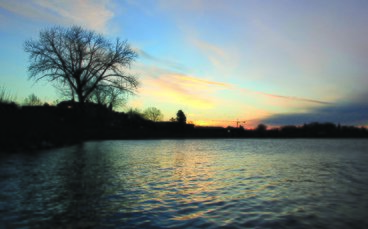
St. Alban’s, Robinson’s bays will be site of zebra mussel research project
A control research project on zebra mussels is planned for this summer on Lake Minnetonka. The study will begin in early May and will be completed in October, during which temporary lighted buoys will be installed at sampling locations.
The treated area will be in St. Alban’s Bay and the control area will be in Robinson’s Bay. The purpose is to evaluate the use of low-dose copper treatments, under the brand name EarthTec QZ, to manage zebra mussel populations by suppressing their early life stages.
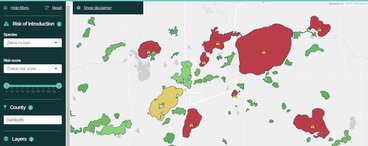
Collaborating with counties to optimize AIS inspections
A model created by MAISRC researchers to optimize watercraft inspection checkpoints to prevent the movement of starry stonewort and zebra mussels has now been pilot-tested with three counties: Crow Wing, Ramsey, and Stearns.
The model — a product of another MAISRC project — incorporates estimates of boater movement among lakes within each county and assesses risk of AIS spread based on boater movement and environmental suitability conditions. The model can be used by counties to allocate their limited inspection resources among various lakes and landings. It can help counties decide how many inspectors to hire, where to station them, even what times of days or days of the week they should be scheduled, for the optimal intervention of AIS.
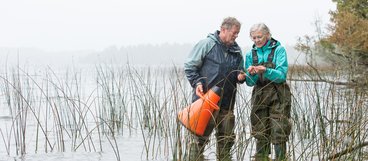
Column: Put time on the water to good use this summer
Get free training to become a volunteer AIS Detector
“So much of Minnesota’s culture and recreation is based around the water and enjoying our lakes and rivers,” says Dan Larkin, an Assistant Professor and Extension Specialist with the University of Minnesota. “And so, aquatic invasive species and other threats to those habitats really affect people personally.”

Scientists call on Minnesota to combat invasive grass
There's still time to stop an invasive grass that's threatening to spread in wetlands across Minnesota, according to some scientists.
The Minnesota Aquatic Invasive Species Research Center is warning the state about invasive phragmites, an invasive strain of wetland grass that grows faster, taller and thicker than its native counterpart.
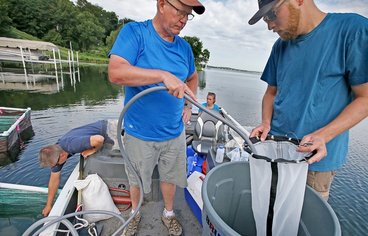
New boat designs could help stop spread of aquatic invasive species
New boat designs can help reduce the spread of zebra mussels in Minnesota lakes and rivers. That's the finding of a new research project just completed by the Minnesota Aquatic Invasive Species Research Center.
Boats are notorious for spreading invasive species like zebra mussels.
For the last three years, MAISRC graduate student Adam Doll has been collecting water samples from compartments in watercraft, including live wells, ballast tanks and motors. He then looked for zebra mussel larvae (veligers).
"We wanted to know where the water was, if it varied by compartment and how much was left," said Doll. "And then lastly, we wanted to know where zebra mussel veligers were."
The samples were collected from Lake Minnetonka and Gull Lake, both of which have established zebra mussel populations.
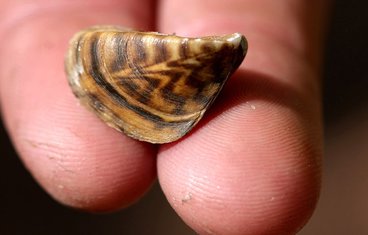
Researchers find new methods to combat invasive zebra mussels
A University of Minnesota study released last week looks at ways to kill as many of one of Minnesota’s most harmful invasive species as possible.
Zebra mussels have encrusted boats, disrupted food chains and cut the feet of beach-goers across Minnesota for decades. In an effort to reduce their population, a paper released by the University in partnership with the U.S. Geological Survey demonstrates the most effective ways to eradicate the inch-long critters, even in the icy waters of the North Star State.
Most chemicals used to exterminate zebra mussels are developed and tested in the warmer states located south of Minnesota, said James Luoma, a USGS researcher who was one of the leaders of the study. While these chemicals may work efficiently in warmer climates, they do not operate as well in the frigid waters of Minnesota lakes in the fall, he said.
“A lot of these infestations are found late in the year when people are removing equipment such as docks or boats,” Luoma said. “In the past, [those treating zebra mussels] did not have the information available to [determine if] a product would be effective in cold waters.”
This sucks: U of M researchers hope to turn the ‘salmon cannon’ into a carp vacuum
A Washington state company attracted national attention a few years back for introducing a flexible pneumatic tube, aka the “salmon cannon,” to help launch the migrating fish past dams and other barriers.
The peculiar gadget, owned and invented by Whooshh Innovations, so captured the public’s imagination that it earned a segment on comedian John Oliver’s HBO show, “Last Week Tonight,” in which Oliver lobbed fake fish at celebrities. “In your darkest moments of despair, when you see a world torn apart by war,” Oliver said with a smirk, people should remember the salmon cannon as evidence that “we can do great things.”
Now, in Minnesota, researchers are studying whether the salmon cannon could be put to a new — if morbid— task: sucking up thousands of invasive common carp from the state’s lakes and marshes.
Przemek Bajer, a research assistant professor at the University of Minnesota’s center for aquatic invasive species and owner of consulting company Carp Solutions, has been working to develop the novel approach to carp management for more than a year in the Rice Creek Watershed, aided by funds from Minnesota’s Environment and Natural Resources Trust Fund.
For the U team, the salmon cannon brings more than flash; it has serious potential advantages over typical carp removal methods around Minnesota, which Bajer said can be time and labor intensive.
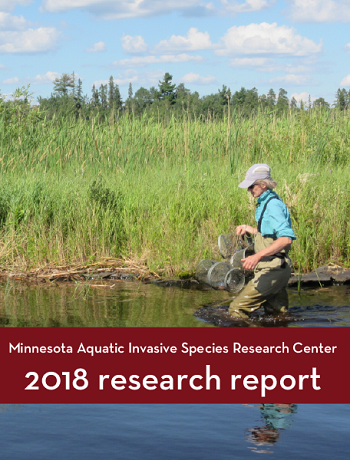
2018 Research Report
Dear friends,
2018 was an exciting year at the Minnesota Aquatic Invasive Species Research Center! We started the year by receiving 20 submissions to our 2018 Request for Proposals, a new record. We funded seven new projects, including evaluating the efficacy of copper-based control on zebra mussels, an economic analysis of ecosystem services as they relate to common carp, creating a new tool for eDNA collection, research into the genetic control of common carp, and more.
Over the summer, we conducted our biannual Research Needs Assessment, and collected input from over 400 stakeholders. This process directly informed our 2019 Request for Proposals, which will allow us to fund projects starting in July 2019. We hosted 270 lakeshore association members, agency representatives, researchers, and concerned members of the public at our fifth annual AIS Research and Management Showcase in September (Missed it? Save the date for next year: Sept. 18, 2019).
